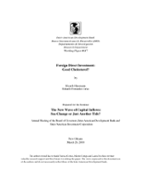Foreign Direct Investment: Good Cholesterol?
Date
Mar 2000
This paper studies the proposition that capital inflows tend to take the form of FDI -i.e., the share of FDI in total liabilities tends to be higher- in countries that are safer, more promising and with better institutions and policies. It finds that this view is patently wrong since it stands the historical record on its head. It then uses alternative theories to make sense of the facts. It begins by studying the determinants of the size and composition of the flows of private capital across countries. It finds that while capital flows tend to go to countries that are safer and have better institutions and financial markets, the share of FDI in total flows is not an indication of good health. On the contrary, countries that are riskier, less financially developed and have weaker institutions tend to attract less capital but more of it in the form of FDI. Hence, interpreting the rising share of FDI as a sign of good health is unwarranted. This is even more so, given that FDI's recent rise has taken place while total private capital inflows have fallen.



